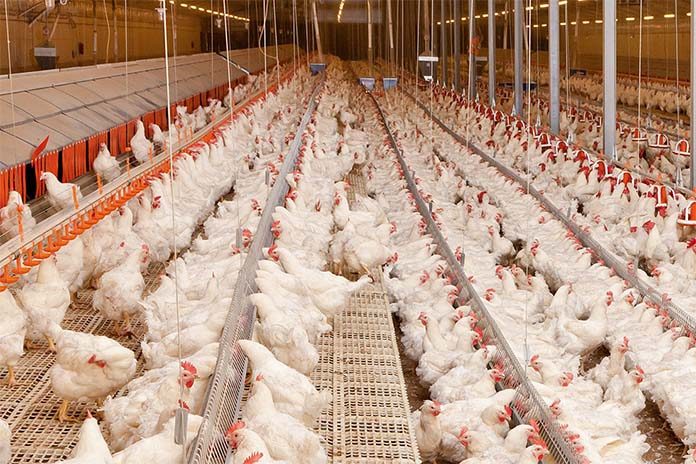
Today, our goal is to control and eliminate all Salmonella species and pathogens from the breeding program. The ability of the primary breeder to supply Salmonella free parent stock to the broiler industry is a key component of this industry’s attempts to reduce or eliminate Salmonella from the finished product, as well as meet increasingly stringent export requirements.
The major emphasis for preventing Salmonella infections is to avoid their introduction into the farms, hatcheries and feed mills through a robust and effective biosecurity program. This requires the establishment of barriers and the implementation of practices aimed at suppressing the most common sources of infection.
In order to reduce the level of Salmonella in finished product it may be beneficial to utilize pre- harvest biosecurity and intervention programs. The cost and effort required for these programs ultimately depends on one’s goals. The area of live production likely to have the greatest initial impact is the breeder program. This presentation will focus on biosecurity and intervention programs that, based on our experience, are most likely to have a significant impact and are worth considering as components of a pre-harvest Salmonella reduction program.
Feed and feeding systems
In poultry operations with strict biosecurity practices feed may be the most common source of salmonellas. Many species found during routine monitoring of the feed mill environment and feed ingredients can be found later in the environment of breeder flocks and in their offspring. In fact, breeder flocks act as biological filters and amplifiers of salmonellas that adapt well to their intestine and internal temperature. Nothing can spread Salmonella throughout an operation more quickly, especially in highly susceptible young pullet flocks, thus, an effective control program must reduce the level of feed contamination.
Animal protein is more frequently contaminated than plant based feedstuffs and should be avoided in the manufacture of breeder feed; however plant-based ingredients can also pose a significant risk. Salmonella reduction can be accomplished with heat treatment, chemical additives or a combination of both. The most effective method for eliminating enterobacteria from the feed is a heart treatment that can achieve a 5 log reduction of coliforms. However this is costly and will reduce plant through put. A significant reduction (3 log) can be achieved by using a horizontal cooker conditioner and treating the feed for 4 minutes at 80°C (176°F). Chemical treatments (usually organic acids) can be added into the mixer and/or post-pelleting. Formaldehyde treatments without additional heat treatment are also effective. Europe allows an inclusion rate of 4.5 kg per ton of feed while the maximum rate in the USA is 3.0 kg per ton. The use of organic acids will reduce the length of conditioning from 4 minutes to 2 minutes at 80°C. Another option that has been quite successfully in the USA utilizes high levels of both organics acids (8 lbs/ton) and formaldehyde product (3 kg/ton) with conditioning for 30 seconds followed by pelleting. The moisture level of the finished feed should be no greater than 13.5% in order to inhibit bacterial growth.
Chemical treatment products have also been useful to maintain clean silos, feed milling equipment, feed delivery vehicles and feed distribution equipment at the farm.
It is important to have separation between the dirty (pre-process ingredients) and clean (processed/treated feed) areas of the feed mill to avoid recontamination of the finished feed. Separation is particularly important for the pellet cooler as this area is prone to contamination because of the condensation associated with pellet cooling and the large volumes of air introduced to cool the feed.
Rodent
Rodents are major vectors and reservoirs of Salmonellas. Besides their role in increasing the level of contamination in the environment, rodents can effectively transmit the infection to other houses and farms. Therefore, it is critical to prevent rodent access to feed, water and shelter by:
- Building rodent-proof poultry houses (metal doors and concrete floors);
- Eliminating potential harbourage areas inside and outside the poultry houses;
- Disposing of dead birds and unused or spilled feed promptly and securely;
- Routine inspection, rodent baiting and trapping – it has been particularly beneficial to have dedicated employees managing this process
House cleanout and disinfection
House cleanout and disinfection procedures are an integral part of the biosecurity program. These procedures are required between growing cycles to eliminate or reduce the concentration of salmonellas and other pathogens that may infect subsequent flocks.
While the cleaning and disinfection of both pullet and hen farms between flocks is standard operating procedure in most of the world it is common practice in the USA to raise pullets on built up litter. For a reduction program to be successful pullet chicks need to be placed in an environment free of Salmonella. An environmental monitoring program on the pullet farm will provide information on the farm status and can be used to determine whether the farm should be cleaned before its next placement.
While many disinfectants are effective against salmonella, in our experience the use of liquid formaldehyde spray does an excellent job eliminating salmonella from a facility.
Hatchery
Chicks may be exposed to salmonella in the hatchery, either by exposure to infected hatch-mates or from environmental contamination. Young chicks are highly susceptible to salmonella infection even with a low level of challenge so the hatchery is an area with a high risk for cross- contamination. This risk can be reduced if hatches can be set taking into consideration the Salmonella status of the contributing flocks so that potentially positive chicks are hatched and serviced after the negative chicks. Interventions like fumigation of the hatchers during hatch may limit cross-exposure. Essential components of a Salmonella control program in the hatchery are robust biosecurity and hygiene programs. A routine environmental monitoring program should be implemented to evaluate their effectiveness. Single stage incubation provides a higher degree of biosecurity as it allows the segregation of hatching eggs and chicks sourced from Salmonella positive breeder flocks. Delivering the chicks in vehicles that have been cleaned and sanitized is desirable.
Actions
An effective biosecurity program that prevents the introduction and infections caused by enteric pathogens is the primary means to protect valuable breeding stock. However, the use of interventions may be a useful tool in a Salmonella reduction program. Immunization has been used strategically to protect at risk flocks and prevent vertical transmission. Inactivated salmonella vaccines formulated against specific serotypes have shown benefits for breeders and their offspring. Generally two and no more than four serotypes are incorporated into the bacterin and their selection is based on prevalence within the operation and the potential impact on public health. The induction of immunity in the hens against specific salmonella serotypes prior to the onset of egg production helps to reduce the risk of vertical shedding. Also, field experiences suggest that maternal antibody can protect chicks against early exposure. Bacterins are one of the most widely used interventions for Salmonella control.
Several live salmonella vaccines are commercially available and may protect against specific Salmonella species by reducing the risk of colonization and persistence. They may also prime the immune system resulting in a better response to bacterin administration. Antimicrobial treatment programs are becoming less effective at reducing environmental shedding and egg transmission of salmonella. The currently approved antimicrobials are not very effective and there is continuing regulatory pressure to reduce the use of all antimicrobials. If used, success is dependent on two factors; selection of the most appropriate antimicrobial treatment program, and moving the treated flock to a clean house so that the flock is not re- exposed to environmental contamination. Antimicrobials have been used to effectively reduce the level of Salmonella in pullet flocks when applied before and after their transfer to the lay farm.
Healthy intestinal flora has shown to protect chickens against colonization by salmonellas and other pathogenic bacteria of the intestinal tract. The use of defined and non-defined avian gut flora (competitive exclusion) has been shown to aid chicks to establish a normal flora that protects them against Salmonella infections. Other bacteria such as Lactobacillus (probiotics) have been used to maintain a healthy intestinal flora and help flocks during periods of stress or after antibiotic treatments.
Evolving methods and products used to manipulate intestinal microflora are becoming increasingly important since there is mounting public pressure against the use of antibiotics in food animals. The use of organic acids, probiotics, probiotics and nutraceuticals has demonstrated some promise in promoting normal flora and inhibiting colonization by enteric pathogens. Each company must evaluate the interventions most suitable to their operations.
Water management
Drinking water can be another source of Salmonella and enteropathogenic E. coli. Chlorination (3-5 ppm) and other methods of water sanitation are an effective means of reducing exposure to pathogens and boosting flock performance. Water pH (< 6.5) can enhance the effectiveness of chlorine and other water sanitizing agents.
Water activity in the litter has a direct effect on the level of Salmonella in it. Increased moisture levels promote the survival and transmission of Salmonellas. Water restriction programs and the use of closed drinking systems, along with proper ventilation (electronic controllers) have resulted in reductions of moisture and levels of Salmonella in the poultry house environment.
Control
A monitoring system for Salmonella is essential to determine the effectiveness of routine biosecurity, hygiene practices and interventions. Monitoring the pullet farm allows one to determine if antimicrobial treatment is warranted prior to move and whether cleaning and disinfection of the farm will be necessary. Periodic monitoring of the lay farm will define the flock status and this information can used to reduce risk of horizontal spread at the hatchery. Collecting manure samples using two pair of boot (shoe cover) swabs has proven to be a sensitive method for detecting Salmonella with the chicken house. Routine environmental monitoring at the hatchery provides a useful indicator of the level of salmonella contamination being brought into the hatchery as well as a method to determine if hatchery has become a source of Salmonella that may require more rigorous sanitation practices. Recommended procedures for sample collection and testing protocols can be found in the provisions of the National Poultry Improvement Plan (NPIP).
Conclusion
Public concern and regulatory efforts regarding Salmonella in poultry and poultry products will continue to increase. Interventions at the processing plant have been highly effective at reducing the incidence, however for some companies to continue to improve it may require reducing the level of Salmonella introduced into the processing plant. The logical starting point is to reduce the level of Salmonella in the parent stock. Efforts that include feed treatment, rodent control and the utilization of bacterin and other interventions have been proven to significantly reduce the incidence of Salmonella in breeder flocks under commercial conditions.
By Courtesy of Aviagen® and E.L. Jensen
Article taken and adapted from the Proceedings of the National Meeting on Poultry Health and Processing, Ocean City, Maryland.

















